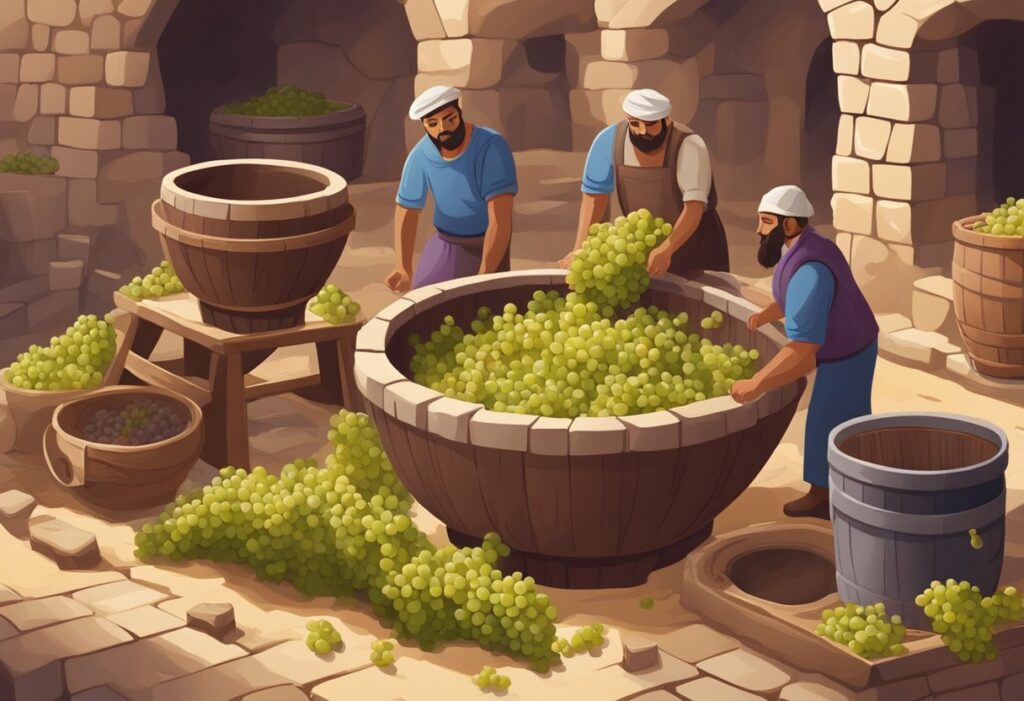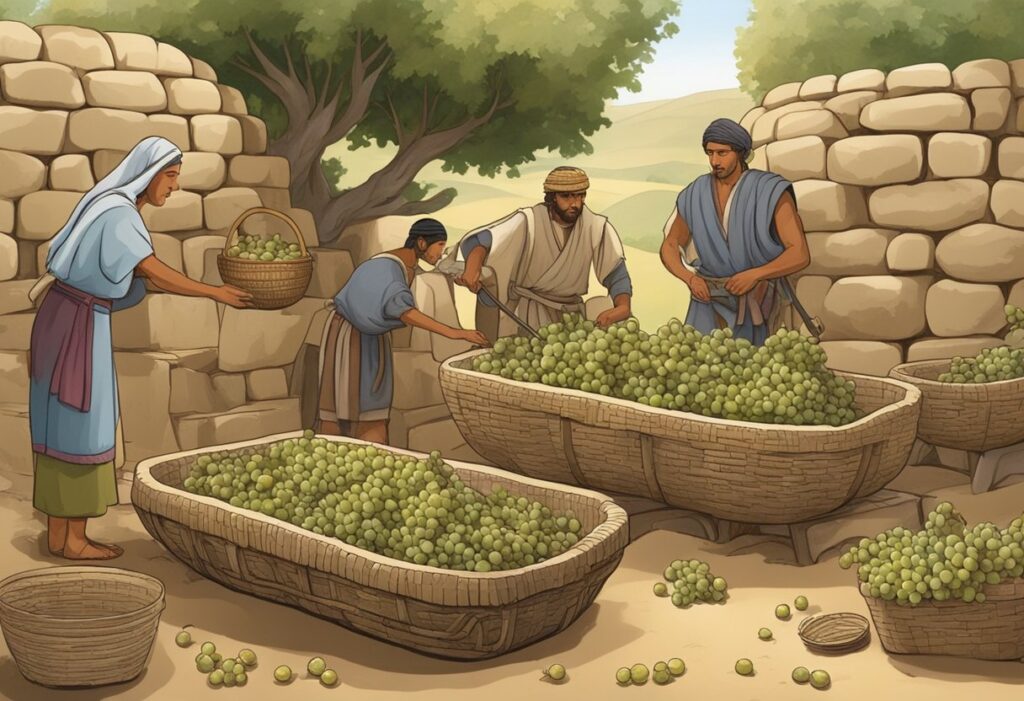Throughout history, wine has not only been a beloved beverage but also a significant form of currency and trade. Wine as currency was prevalent in ancient Rome, where it connected vast regions of the empire and facilitated commerce. Romans were known for their voracious appetite for wine, and it played a crucial role in their economy, sometimes even serving as payment for soldiers.

During the Renaissance, wine’s importance grew as trade routes expanded. This era saw wine travel further than ever, enhancing commerce and spreading culture. The growth in trade led to wine becoming a symbol of wealth and refinement, contributing to the thriving economies of the time.
Exploration and globalization further solidified wine’s role in trade and commerce. In the 19th century, the liberalization of trade saw world wine exports grow, although challenges like disease outbreaks reshaped the market. Yet, wine’s ability to adapt ensured its continued significance in global trade. Dive into these fascinating historical instances and discover how wine shaped economies and societies across different eras.
The Roots of Wine in Trade
Wine has played a crucial role in commerce throughout history, beginning with ancient exchanges and evolving into a symbol of social and economic status. Understanding these developments sheds light on the profound impact wine has had in trade and culture.
Ancient Exchanges and the Value of Wine
In prehistory, wine wasn’t just a beverage; it was a valuable commodity. Early evidence shows that wine production began in the Near East. From there, it spread to Mediterranean regions. Ancient civilizations like the Egyptians and Phoenicians traded wine extensively.
Phoenician traders transported wine in large quantities across the Mediterranean. Wine was often traded for other goods, such as precious metals, spices, and textiles. These ancient exchanges highlight the importance of wine as both a drink and a currency.
The city of Rome consumed vast amounts of wine, with annual consumption reaching hundreds of millions of liters. This high demand made wine a bustling trade item in the ancient economy. You can read more about this in the Organization of Rome’s Wine Trade.
From Barter to Symbol: Wine’s Ascension in Commerce
As wine became more popular, its role in trade evolved. It transformed from a simple barter item to a symbol of wealth and social status. This shift was significant in ancient societies.
In Greece and Rome, wine was often given as gifts to cement alliances or express goodwill. During the Roman Empire, fine wines were highly sought after, symbolizing luxury and refinement. Wealthy families showcased their status by hosting lavish wine banquets.
Wine also became intertwined with religious practices. In Christianity, for instance, wine symbolizes the blood of Christ in the Eucharist. This religious importance further boosted wine’s status in the market.
The shift from barter to symbolic use can be explored in more detail in Wine and the Vine: An Historical Geography of Viticulture and the Wine Trade.
Wine’s Role in Economic Evolution
Wine has played a key part in shaping economic development across different eras. Its influence can be seen in Medieval Europe and the rapid changes of the 19th century.
Medieval Vineyards: Monastic Orders and Trade Routes
In medieval Europe, monastic orders were among the first to cultivate extensive vineyards. These monks, especially in France and Italy, produced wine for religious ceremonies and local consumption. Their vineyards became centers of wine production, setting quality standards and developing techniques still in use today.
Trade routes facilitated the distribution of wine far and wide. Key routes connected major wine-producing areas to markets across Europe. This trade helped local economies grow as wine became a valuable commodity. Wine trade supported the establishment of important economic links between regions.
Wine’s steady demand encouraged an efficient system of production and trade. Merchants and traders prospered, contributing to economic growth. Monks’ meticulous record-keeping also helped standardize wine measurements and pricing. This practice laid the groundwork for future economic frameworks in the wine industry.
The 19th Century: Industrialization and Expansion
The 19th century brought industrialization, transforming wine production and distribution. New technologies allowed for larger-scale production. This was especially notable in France and Italy, which saw an increase in vineyard area and output.
Railways and steamships improved transport, enabling wine to reach distant markets quickly. These advancements expanded trade routes to include not just Europe but global markets. This period marked a significant expansion in both the scale and scope of wine trade.
Economic policies also evolved to support the growing industry. Governments established regulations to protect the quality and reputation of their wines. These efforts fueled economic evolution by ensuring consistent, high-quality output, boosting international trade.
The rise of commercial wineries in the 19th century underscored wine’s importance in economic development. As industrialization progressed, wine cemented its role not just as food and culture but a central economic driver.
Cultural and Governmental Impact on Wine Commerce

The commerce of wine has been shaped by cultural traditions and governmental regulations. These aspects play a vital role in defining the quality and identity of wine across the world.
Regulations and Quality Control: The Influence of Law
Governments have long used laws to control wine production and trade. These laws ensure that wines meet specific standards to protect consumers. For instance, appellation systems like France’s AOC (Appellation d’Origine Contrôlée) regulate where and how wines are made. These laws help preserve regional characteristics and maintain quality.
Taxes and tariffs also impact wine commerce. Governments may raise tariffs on imported wines to protect local producers. Quality control measures, such as inspections and certifications, ensure that wines are safe and authentic. This not only protects the consumer but also maintains the reputation of the winemaking regions.
Laws related to advertising and labeling must be followed strictly. This transparency ensures that you know exactly what you are drinking and where it comes from. With a keen legal framework, the integrity of wine as a product is maintained.
The Communion of Wine and Culture: Tradition and Identity
Wine is deeply embedded in many cultures. In places like Italy and France, wine is more than a drink—it is a symbol of national identity. Families pass down winemaking traditions over generations, preserving unique methods and flavors.
Religious ceremonies have historically involved wine. During Christian Eucharist services, wine symbolizes the blood of Christ. Such traditions emphasize the cultural significance of wine. Festivals celebrating wine harvests, like France’s Beaujolais Nouveau Day, highlight its cultural importance.
Local customs influence wine’s role in social gatherings. For instance, in some Middle Eastern cultures, wine is tied to ancient rituals and celebrations. This rich cultural fabric weaves wine into the social and historical context of many regions, making it not just a commodity but a key cultural artifact.
By acknowledging and respecting these traditions and regulations, you gain a deeper appreciation for the complexities involved in wine commerce.
Innovation and Technology in the Wine Industry

The wine industry has been revolutionized by advancements in scientific knowledge and technology. These changes have impacted viticulture, glassmaking, storage, and international trade.
Scientific Advancements and Viticulture
Scientific advancements have transformed viticulture, the science of growing grapevines. Precision agriculture uses technology like drones and sensors to monitor vineyard conditions. This helps manage water use, soil health, and pest control more efficiently.
Another key innovation is climate modeling. Winemakers can predict weather patterns and adapt their practices accordingly. This reduces risks and maximizes grape quality.
The development of genetically modified grapevines has introduced more resilient plants. These vines are resistant to diseases and pests, reducing the need for chemical treatments. This not only protects the environment but also improves the quality of the wine.
Glassmaking, Storage, and Global Trade
Glassmaking innovations have improved the process of creating wine bottles. Modern glass is stronger and lighter, reducing shipping costs and breakage. Eco-friendly options, like recycled glass, help reduce the industry’s carbon footprint.
Storage technology has also evolved. Temperature-controlled systems ensure that wine ages perfectly, preserving its taste and quality. Advanced corks and synthetic closures prevent spoilage and oxidation.
Global trade benefits from these technological improvements. Efficient storage and shipping mean that wines can travel long distances without losing quality. This allows you to enjoy wines from around the world, expanding your palate and supporting international commerce.
The Modern Era of Wine: Globalization and Economy

In recent years, the wine industry has experienced significant changes due to globalization. Key factors include the rise of New World vineyards in America and Australia and their impact on international marketplaces.
The New World Influence: America and Australia’s Vineyards
With the 20th century came a shift in global wine production. Vineyards in the United States and Australia began to gain popularity. California’s Napa Valley and Australia’s Barossa Valley are now recognized globally for producing high-quality wines.
The internationalisation of wine production has led to a greater variety of wines available worldwide. Producers from these regions focus on innovation and marketing strategies that appeal to modern consumers. The result? You enjoy a greater selection of wines at various price points.
The influence of these New World vineyards has also increased competition, encouraging improvements in wine quality and diversity. The introduction of unique grape varietals and modern winemaking techniques further enhances the global wine scene.
International Marketplaces and the Future of Wine Trade
Globalization has drastically changed the dynamics of the wine trade. International marketplaces have become more interconnected, allowing wines from virtually any region to be sold globally. This has benefited both producers and consumers, enhancing accessibility to a wide range of wines.
Digital platforms play a significant role in this development. Online wine shops and virtual wine tastings have made it easier for you to discover and purchase wines from different parts of the world. The ease of access and competitive pricing in international markets drive the wine industry forward.
Looking ahead, the future of the wine trade will likely continue to evolve with advancements in technology and shifts in consumer preferences. Sustainability and eco-friendly practices are becoming more important to producers and consumers alike, shaping how wine is produced and traded on the global stage.

